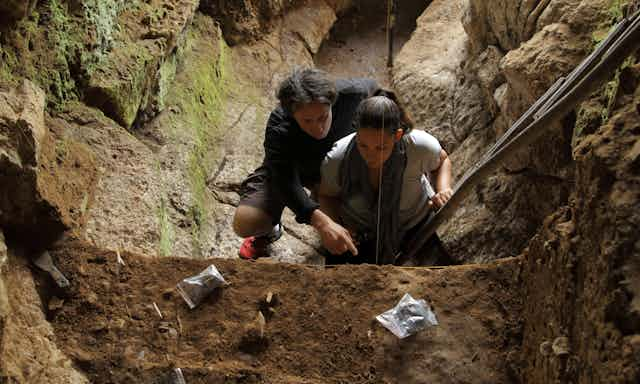A new study has dated the final days of the Neanderthals and found they lived at the same time as the earliest modern humans in Europe. Rather than seeing Neanderthals suddenly vanish at the time modern humans appeared in Europe, we see a patchwork of the two species living side by side for several millennia.
The study, published today in Nature, explores two of the key issues in Palaeolithic archaeology: did Neanderthals and modern humans meet, and how did they interact?
In 2010, the Neanderthal nuclear genome was published. This showed that around 2% of DNA in non-African humans was from Neanderthals. So we know that the two did meet and did interbreed.
But there is very little evidence to tell us where and how many times this interbreeding took place, and if any cultural exchange occurred at the same time.
When modern humans appeared
One possible meeting place was Europe between 50,000 and 30,000 years ago. During this time, Neanderthals disappear from the European archaeological record and modern humans first appear, having migrated out of Africa.
Very few Neanderthal and modern human fossils are found in this time period. Instead, archaeologists find assemblages of stone tools, together with shells and bones. These stone tool assemblages have been grouped into “industries” that contain similar types of tools made in similar ways.
The Mousterian is an industry found across Europe. Where we have hominid fossils in the same archaeological layers as the Mousterian in Europe, they are always Neanderthal. This suggests Neanderthals made the European Mousterian.
The Châtelperronian industry found in France and the Uluzzian industry found in Italy occur in sediment layers above the Mousterian. Neanderthals probably produced the Châtelperronian but recent work in Italy has suggested that modern humans made the Uluzzian.

Layers containing the Châtelperronian and Uluzzian also contain pendants. These provide evidence for symbolic activity. For a long time, this has been thought of as a hallmark of modern humans.
Lengthy debates have raged for more than a decade over whether Neanderthals producing the Châtelperronian independently came up with the idea for this new type of stone tools and symbolic activity, or whether they borrowed the idea from modern humans in neighbouring areas.
This new study, by Thomas Higham from the University of Oxford and a team including myself and numerous European archaeologists, aimed to go back to the basics and, using radiocarbon dating, identify whether modern humans and Neanderthals were in different parts of Europe at the same time.
Problems with radiocarbon dating
This sounds simple, but radiocarbon dating reaches its limit at around 50,000 years. From around 30,000 years it is extremely sensitive to modern contamination. Just 1% modern carbon in a sample of 50,000 years will produce a radiocarbon date of 37,000 years.

In the region I worked, Spain, the warm climate rapidly degrades bone and charcoal. This has made radiocarbon dating particularly difficult.
When we re-dated some Spanish Mousterian assemblages, previously placed at around 30,000 years old, we obtained ages beyond the limit of the radiocarbon method. In reality, the samples were more than 50,000 years old and the young dates were just contaminated.
This means that although there were already several hundred radiocarbon dates from this period, it was impossible to work out which dates were correct and which dates were contaminated. Many people had tried but they all came up with different answers.
This new project dated more than 200 samples of bone, charcoal and shell from 40 archaeological sites. Only radiocarbon techniques known to effectively remove contamination were used. These included a method for cleaning charcoal developed at the Australian National University in the late 1990s.
Although some Neanderthal fossils were dated, the vast majority of dates were on butchered bone, shell pendants or charcoal from campfires. For the first time, we had a large reliable group of dates on samples that can be directly related to human activity.

Together, these dates showed that the Mousterian finally disappeared by 41,030 to 39,260 years ago. Most importantly, the Mousterian appeared to have ended at different times in different places.
In some regions of France and Italy the Mousterian disappeared slightly earlier, and was replaced by the Châtelperronian or Uluzzian.
This means that for between 2,600 to 5,400 years, three different types of stone tool industries were produced in different parts of Europe. All three industries stopped being produced at the same time.
The significance of this overlap depends on who produced which industry. I’ve already outlined the most likely scenario.
Neanderthals produced the Mousterian and Châtelperronian, and modern humans produced the Uluzzian. If this was the case, then it is possible that interbreeding took place in Europe.
It is also possible (although not proved) that Neanderthals could have borrowed the ideas for the Châtelperronian and symbolic activity from modern humans. Some suggest that this would mean Neanderthals were cognitively inferior to modern humans.
But it must be borne in mind that we have very few hominid fossils from the period. It is possible that some of the relationships between hominid and stone tool industry may change when new discoveries are made. This latest study provides a dataset to assess what the implications of these finds may be.

